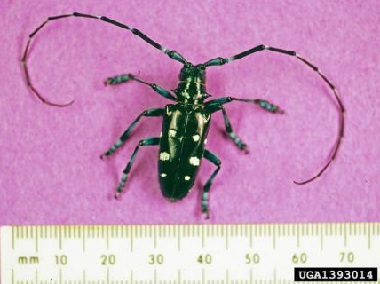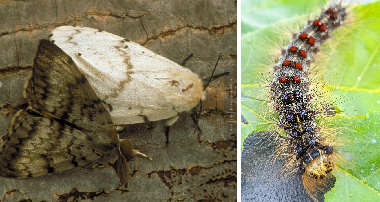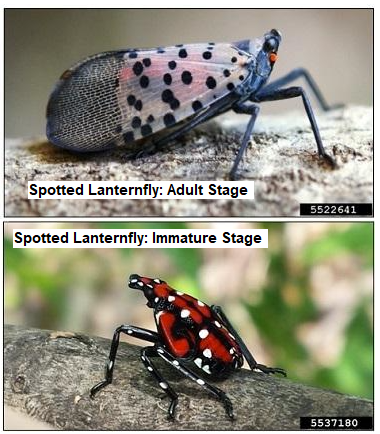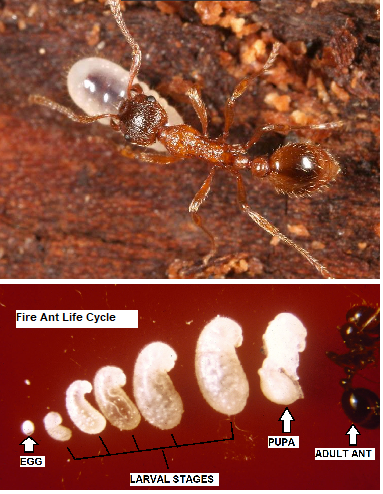Invasive Species: 4-H KY Keepers
Keep the KREEPERS out of Kentucky!
Like goal keepers, the 4-H KY Keepers work to STOP invasive species from spreading in Kentucky. KY Keepers are small teams of 4-Hers who work with their local county 4-H agents to learn about invasive species, find them, and slow them down them by setting traps and educating the public (Spread the Word and Not The Pest!)
JOIN a KY Keepers chapter by contacting your local 4-H agent. There's one in each Kentucky county, at the local Extension office (https://extension.ca.uky.edu/county).
What Is An Invasive Species?
An invasive species is a plant, animal, or other organism that becomes a problem to people or to the environment when it moves from one part of the world to another.
Invasive Insects That Currently Threaten Kentucky
ASIAN LONGHORN BEETLE (ALB)

Originally from Asia, the Asian Longhorn Beetle came the USA in 1996. It may have arrived accidentally on packing equipment but no one really knows how it got here. ALB is a large black beetle with white spots and long antennae. The beetle itself is harmless to people, pets, and plants, but when it lays its eggs on the bark of certain trees, the worm-like larvae hatch and burrow into the trees, eventually killing them. Since the larvae are protected deep inside the tree, they are really eaten by predators. The larvae then turn into pupae, emerge as adults, and lay more eggs! ALB hasn't been found in Kentucky yet, but it has been found in southern Ohio, just a few miles from the KY border. ALB kills maple trees and other hardwood trees, including boxelder, birch, horse chestnut, poplar, willow, elm, hackberry, sycamore, mimosa, and ash. Once they live in an area, control of ALB is very difficult because the larvae are protected inside trees. So, sometimes they are controlled by cutting and grinding up the trees that they live in, along with any possible nearby trees that they might be living in. Another control measure is to put an infested area under quarantine. In a quarantined area, it is illegal to move wood from the area to a place that is not infested yet. KY Keepers can help by reporting any sightings of the adult beetles. Whether you're on a KY Keeper team or not, if you see something that might be an ALB, take a picture or capture it (they are harmless to people) and let your 4-H agent know where it was found. It is also important to educate Kentuckians about ALB. One way that they can spread is from firewood that campers bring from one state to another. The larvae can be hiding in the firewood! For this reason, KY Keepers ask Kentuckians to use firewood that they find locally, rather than moving it from one state or county to another.
SPONGY MOTH

Originally from Europe, the Spongy Moth was released on purpose in 1869, in Massachusetts, in a failed attempt to breed a new kind of silk-producing insect. The moths eventually escaped and their larvae have been killing trees in the eastern USA since then. While the moths are harmless, they lay hundreds of eggs at a time and cover them with a protective substance. They have the same life cycle as all moths and butterflies, with egg, larva, pupa (cocoon) and adult stages. Adult females lay many eggs and cover them with a spongy substance that helps protect them from predators and the weather. When the larvae hatch from the eggs, they feed on the leaves of oak trees and many other trees as well. While the larvae don't kill the trees right away, they can eat all of the leaves each year, eventually weakening and killing the tree. Larva are covered with hairs that help protect them from many predators. The Spongy Moth does millions of dollars of damage each year as is slowly spreads south and west. Spongy moths are occasionally found in Kentucky, but we do not have any large populations of it. KY Keepers help to monitor Kentucky's population of Spongy Moths by setting up and monitoring special traps each year.
SPOTTED LANTERNFLY (SLF)

The Spotted Lanternfly is not a fly, but belongs to a group of insects called the "planthoppers." SLF is a very striking insect with pink and black wings that is native to Asia. In 2014 It came to USA on accident: SLF adult females lay their protected eggs on objects, sometimes things like shipping crates that get moved around the world. SLF is a pest because it feeds on a lot of different plants, and can be a major pest of crops like soybean and grapes that are grown in our area. Like all planthoppers, SLF uses "piecing and sucking" mouthparts that are shaped like a tube and are built to suck sap out of leaves. Because they suck sap all day, they also "pee" frequently. This is called honeydew and is very sticky. When too much of this pee gets on plants and fruits it causes "sooty mold" to grow which can be a big problem especially for fruits. SLF grows quickly and lays lots of eggs, and the female covers the eggs with a substance that protects the eggs from the weather and predators. SLF's begins life as an egg, hatches into a immature stage (nymph), and then changes into a winged adult. A population of them can grow fast and quickly overtake and cause lots of damage to plants. Predators rarely catch and eat spotted lanternflies because they can jump and fly to escape, and they also taste bad because of the chemicals in the plants that they eat. While SLF is harmless to people and pets, both the immature and adult stages feed on plants. SLF hasn't been found in Kentucky yet, but it has been found in southern Indiana, just a few miles from Kentucky. KY Keepers and others can help by letting us know if they see this creature. The KY Keepers app even includes a place where pictures of suspected SLF can be quickly uploaded to our system, where experts can take a look and see if action is needed. Education is important to keeep this creature from spreading: the more people that know what it looks like and who know to report it to us, the more chance we have of finding it and stopping it!
RED IMPORTED FIRE ANT (RIFA)

Originally from South America, the Red Imported Fire Ant showed up in Alabama sometime prior to the 1950s. It was probably brought over in cargo ships: fire ants can spread if parts of their underground colonies are shipped from one place to another in things like potted plants or soil. Like all ants, RIFA's life cycle starts as an egg, hatches into a worm-like larva, then forms into a pupa. Adult ants then emerge from the pupa. Most parts of this life cycle are protected in underground colonies; only the adult ants to find food and defend the hive. Fire ants are effective at invading new areas for a variety of reasons. For one, fire ants eat lots of things, including dead animals, nectar, insects, and seeds. So they can find food almost anywhere. They are also protected from most predators because of their venomous stings and aggressive behavior: whenever the sense a threat to their colony, dozens or hundreds fire ant soldiers will rush out of the earth to sting anything that moves. They are also able to quickly spread as new, winged queens leave the old colonies to set up new hives of their own. Fire ants are a big problem in the southern USA where their intensive underground digging disturbs yards, making it difficult for grass to grow. They are very common in open meadows and yards, so animals like pets, cattle, and horses who stumble upon hives can quickly receive dozens of stings. Fire ants also commonly sting children, gardeners, and anyone who works or plays around hives. Several colonies or RIFA (and its similar relative, the Black Imported Fire Ant) were found in southern Kentucky in 2022. Once these mounds are discovered, they are often controlled by the use of pesticides. KY Keepers can help by reporting suspected mounds. Mounds are often identified by the behavior of the ants: if a nest is accidently stepped on, dozens or more of the small (apx 1/8") soldier ants will rush (or "boil") to the surface and begin stinging in a matter of seconds. CAUTION: do not approach suspected fire ant colonies. Fire ant stings can be dangerous, especially to individuals with a history of serious allergic (anaphylactic) reactions to stings from bees or other insects.
Photos:
Asian Longhorn Beetle: Linda Haugen, USDA Forest Service, Bugwood.org
Spongy Moth adults: USDA APHIS PPQ , USDA APHIS PPQ, Bugwood.org
Spongy Moth larva: Karla Salp, Washington State Department of Agriculture, Bugwood.org
Spotted Lanternfly Adult and Nymph: Lawrence Barringer, Pennsylvania Department of Agriculture, Bugwood.org
Adult Fire Ant: Gary Alpert, Harvard University, Bugwood.org
Fire ant Life Stages: USDA APHIS PPQ - Imported Fire Ant Station, USDA APHIS PPQ, Bugwood.org
